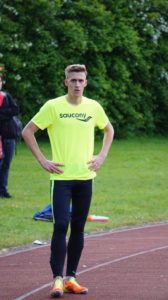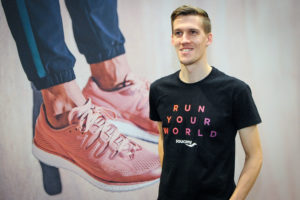
Steeplechase is a hard man’s event. Saucony UK athlete Ieuan Thomas takes us through what it takes!
1) You’ve set PBs this year over 3000, 3000SC and 10K on the road. What three things would you say have most contributed to this?
a) A solid winters training. I train as a 10k runner during the winter and this gives me a great endurance and strength base to build from as we come into the summer season.
b) Consistency in training. I’ve been lucky to not have any major injuries over the last year, meaning training has been consistent with no long training breaks.
c) Having a great group to train with. Both in the winter and the summer this makes a massive difference, especially in the summer when I’m trying to run slightly faster on the track having guys like Jake Heyward and Tom Marshall to chase really helps brings me on to that next level.
2) When did you decide to focus on the chase and why? What was it about the event that appealed?
I started focusing on the chase whilst at university in Cardiff Met. I was always a decent 1500m runner but didn’t seem to be improving as much as I would have expected, and there was always something really interesting about the steeplechase. I’ve always been someone who enjoys a challenge and the idea of doing something a little bit different and dangerous, so steeple had this aura about it. I gave it a try for the first time in a 2km race and ran really well even through my technique was horrendous, so figured there could be an opportunity for me. It wasn’t really until I went to college at Western State in Colorado for my post-grad that I came into my own as a steeplechaser, finally training with other steeplers.
3) Do you train over the barriers all year round? Is it important to be an efficient hurdler to minimise the differential between your flat 3000 and your chase?
It’s incredibly important to be an efficient hurdler, and I still have improvements to be made. We won’t hurdle during in sessions during the winter though. Through the winter months I focus on improving my aerobic capacity and train basically as a 10k runner. I’ll still do hurdle walkover drills 1-2 times a week but won’t actually jump a hurdle during a training session until March or April.
4) Finding time to train is never easy. How do your juggle your days around work?
The balance is relatively easy as it gives you a great structure to your day. You have the early morning to get run #1 in, and then the evening for run or session #2. Recovery is really the hardest part, when you have a full-time job there’s really no let up. You always have to be switched on, which can be mentally tiring. It also means that I can’t attend the training camps that many full-time athletes enjoy as part of their major championships build-up.
5) Are your training sessions geared around time efficiency or is it just quality recovery that suffers?
A bit of both really. Occasionally I have to modify a session to fit around what’s going on with work, if I’m going to be on the road and know I won’t be able to access a track for instance. Very rarely I find myself having to do a workout on the road before work, which usually means starting my warm up somewhere between 6.30-7.00am in order not to have to rush the session, and still get to work on time.
6) How do you phase your training (or coach James Thie)? You compete successfully over a number of distances – is it important for you to continue to work on endurance rather than improve raw speed?
James and I have been working together for nearly 10 years now, and we’re at the point where we both understand my physiology really well, and can design my programme around what we know uniquely is going to work for me. My time in the USA back in 2012-2013 really helped to shape my programme as I realised my body can handle the higher mileage and responds well to more threshold work and longer reps. Over the winter the focus is on strength and endurance, which I why I race cross country and road until the new year. We then keep an aerobic focus through the indoor season, touching base with some more specific track work but without turning the focus completely. Steeplechase is definitely a strength event, you need to be able to handle the breaks in rhythm and forces your body is put under – especially over the water jump.
at the point where we both understand my physiology really well, and can design my programme around what we know uniquely is going to work for me. My time in the USA back in 2012-2013 really helped to shape my programme as I realised my body can handle the higher mileage and responds well to more threshold work and longer reps. Over the winter the focus is on strength and endurance, which I why I race cross country and road until the new year. We then keep an aerobic focus through the indoor season, touching base with some more specific track work but without turning the focus completely. Steeplechase is definitely a strength event, you need to be able to handle the breaks in rhythm and forces your body is put under – especially over the water jump.
7) What’s your favourite session? And your least favourite? And what is the session you do that says ‘right, I’m in shape!’?
My favourite session has got to be 10-12 x 400m. It’s one I get to do with the whole group so there’s always a good pack of us working together. It’s also a session we run a few times throughout the year and you can see progress each time you run it.
My least favourite is probably either a straight-up long tempo or a split tempo with hills. One of the sessions I run a few times a year that is truly a killer is 2 miles, 10 x 20 seconds hills, 2 miles, 10 x 20 second hills. You can hit a nice rhythm on the 2 miles, but then having to come back and run hill sprints is a killer, especially on the second set.
Then the shape session is definitely 3 x 1km with 600m hurdles and 400m flat. 5-10 seconds faster than race pace on each rep. If I nail it, it’s a real confidence booster coming into a big race.
8) How important was the Europeans in terms of your long-term progress?
It was super important. The one thing I don’t have a huge amount of is major championship experience. I need to get used to the way that call rooms work, longer call times and the nature of championships racing where it inevitably starts super slow and then builds and builds through to a sub 60 last lap. My lifestyle isn’t that of a full-time athlete either, so the idea of hanging around in hotel rooms resting and preparing for a race is outside of the norm for me. The more I can do it the better I will be prepared for the next couple of years.
9) Where do you see your running in 5 years time? How fast do you think you can go?
I’d like to think that I can get close to the Welsh record of 8.18, but there’s a fair way to go yet. The goal is to get to the low 8.20’s, as that should be enough for an Olympic place in 2 years time. After that, it will just be about seeing how fast I can actually go. I’ll keep running until I start slowing down/ I have goals on the road too though. There’s times when I don’t think I’ll be competing in the same way in 5 years, others where I’m super motivated to make the next Commonwealths, so we’ll see how my legs hold out!






